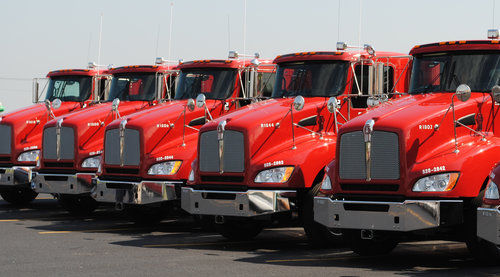
Used Class 8 truck pricing held strong in October and same dealer sales volumes rebounded after a slight dip last month, according to preliminary data from ACT Research.
“The average used Class 8 selling price recorded a sixth straight month above the trend reading,” ACT Research Vice President Steve Tam said. “On a yearly basis, prices continue to enjoy meaningful growth.”
Same dealer sales volumes reversed course in October, rising 10% month-over-month and offsetting September’s 10% decline. Same dealer sales rose 9% year-over-year, with average mileage dropping 1% and average age dropping 2%, according to ACT’s data.
“Analysis of the individual market channels revealed that all three segments, auction, retail and wholesale, posted month-over-month gains, up 81%, 5% and 2%, respectively,” Tam said. “Longer term, the retail and auction markets rose 21% and 3% on a year-over-year basis, with the wholesale market contracting 21% by comparison.”
At a time when used truck pricing is holding strong and new truck orders seem to surge month after month, many wonder when the proverbial crash is coming. Tam thinks the good times are likely to continue into 2019, with the market taking a turn in the second half of the year.
“One of the adages we have is when truckers make money, there’s nothing they hate more than paying taxes. So, much like farmers, they’ll invest in equipment to avoid paying those taxes. Combine that with another perception about truckers that when one of them is making money, they’re all making money, and you get this herd mentality. They all run out into the marketplace and buy equipment at the same time, and I think that’s very much what we’re seeing,” Tam said. “The interesting thing is, if you look at the underlying fundamentals, we do have a very solid freight market right now. It’s peak-ish, in fact, some could argue, if you look at the last couple months, it has actually rolled over. It’s an interesting marketplace.”
Tam said people often ask him why sales are so strong if fleets across the nation are experiencing a shortage of drivers, wondering if trucks end up sitting on the fence without being utilized.
“We’re not seeing them get transitioned off into the used truck market because it is functioning in a very similar, almost parallel fashion. It’s not as if we’re sticking trucks out into the fields and not using them,” Tam said. “When we look at the driver data, the Bureau of Labor Statistics reports the number of new truck driving jobs that are created each month, and over the last year that has been somewhere in the 30,000 to 35,000 unit range. That’s not a bad number. We’ve probably grown the fleet by more than that, but what that BLS survey doesn’t take into account are two things: private fleet drivers and owner-operators.”
Tam used Anheuser-Busch drivers as an example of private fleet drivers who are not counted as truck drivers in the BLS numbers. Instead, they are counted as beer retail employees. The BLS counts owner-operators in a different survey altogether.
“It’s not too hard to put together a plausible story that the good times are upon us. Freight rates are good. Tucker profitability is good,” Tam said. “What ends up happening, almost invariably, is the truckers oversaturate the market. They buy too many trucks, and then you start to see the balance shift. Freight rates start to soften, profitability starts to suffer and then truck purchases retrench. We’re never balanced. We never manage to achieve that equilibrium between the number of trucks and the amount of work to be done. We’re always shooting up through the top or plummeting down through the bottom.”
Tam expects profitability on the trucking side to hold up well through the first half of 2019, then begin to slow down. In terms of order activity, he thinks that has to start slowing down soon, pointing to existing signs that current trends will not continue.
“We saw a sizable jump in cancellations. That’s not, from our perspective, a crisis at the carriers yet. It’s more of a housekeeping thing at the OEMs,” Tam said. “The industry has never had this many units in backlog, and I think they’re having a hard time figuring out how to deliver the trucks everyone wants.”
Tam sees the second half of 2019 as the inflection point, with the production forecast coming down in the late third quarter or early fourth quarter, then slowing meaningfully into 2020. As long as the wider economy and freight specifically hold up, he expects this particular cycle to have a fairly smooth glide path as opposed to just crashing or coming to an abrupt halt.
“All good things must come to an end, and unfortunately, in this industry, the higher the peak, typically the lower the cycle,” Tam said. “For now, as a trucker, how can you not want to participate in a solid market? There aren’t very many folks in any business, whether it’s trucking or pet care, that want to sit on their hands and watch a growing market pass them by.”